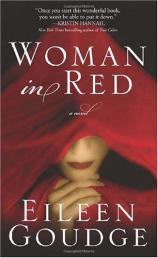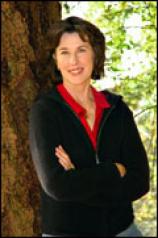Interview: July 13, 2007
July 13, 2007
Eileen Goudge is the author of the bestselling novels GARDEN OF LIES and SUCH DEVOTED SISTERS, as well as over30 books for young adults. In this interview with Bookreporter.com's Eileen Zimmerman Nicol, Goudge describes the inspiration behind her latest work of adult fiction, WOMAN IN RED, and explains how she was able to realistically portray both alcoholism and prison life. She also discusses the differences between writing for adults and writing for teens, and shares details about an upcoming novel set to be published next summer.
Bookreporter.com: What was your inspiration for WOMAN IN RED, and can you share with us why you chose to set the book on an island?
Eileen Goudge: My husband and I are building a home in the San Juan Islands, in the Puget Sound, north of Seattle. We vacationed there a few years ago and fell in love with the island, and now we go there every summer. It's a magical place with a dramatic landscape and climate. I couldn't think of a more perfect setting for WOMAN IN RED.
BRC: Alcohol plays a big role in your novel --- Colin is a recovering alcoholic, Owen a secret one, and Jeremy pays a high price for his drunken escapade. Was this intentional, or just a reflection of real life in fiction?
EG: I come from a family where alcoholism has cut a wide swath. I myself am not a recovering alcoholic (thoughI take it as a compliment when a reader occasionally id's me as one! It means I've portrayed the disease accurately). What I hope readers will take away from my depiction of addiction is a better understanding of it. Only through understanding can we have any hope of combating it.
BRC: Why did you choose to have Colin become interested in oyster farming? Are oysters a symbol in the novel?
EG: I happen to love oysters. They're also prevalent in the Pacific Northwest, where the book is set. In fact, there's an oyster farm on the island where we're building our house. The owner was kind enough to give me a complete tour --- wet feet and all! --- which I used as the model for Colin's oyster farm.
BRC: Alice's feelings of isolation after spending nine years in prison make us identify with her more strongly. Her description of prison life gives readers a snapshot of just how tough this experience is. How did you research prison life?
EG: Mainly, I did a lot of reading on the subject. Also, a little known fact about me is that I have an unofficial prison fan club. I get quite a few letters from prisoners who've read my books and write to say how much they enjoyed them. Often, they tell me their own stories and what life behind bars is like. I find it fascinating, though the personal stories are sad, at times. The only time a prisoner went too far was when one wrote to ask for my shoe size. He also wanted a sample of my perfume.Needless to say, I didn't respond!
BRC: Calpernia, Alice's friend from prison, is larger than life, moreso than any other character. Was there a reason for this?
EG: Calpernia more or less sprang to life in my imagination fully blown. Actually, I’ve known women like her. She fascinates me because she's not afraid of anything, especially not when it comes to speaking her mind. I also love the contrast between white, middle-class Alice and this big, bold, smart-talking black woman. The fact that they become bosom buddies echoes a similar theme in my own life. I have friends like that, whom I might not otherwise have gotten to know if we hadn't been thrown in together. One of my closest friends, and the model for Rivka in "such devoted sisters," was my orthodox Jewish landlady when I was living in Brooklyn years ago.
BRC: The character of Jeremy, Alice's teenaged son, seems particularly convincing. How do you stay in touch with what today's teens are thinking and feeling?
EG: I have two children and quite a few nieces and nephews. Other than that, I make a habit to engage with teenagers on their level, so I know what they're thinking and feeling. I also have a good memory when it comes to my own teen experiences (mainly because they were so traumatic!).
BRC: Alice and Colin's grandmother and grandfather figure prominently in the novel. What is it about the World War II years that drew you to include them in the story?
EG: My parents met and fell in love during World War II. I've always thought of it as a romantic era, in the sense that emotions and relationships were heightened because of the constant threat of death. The love affair between William and Eleanor is a good example of people behaving in ways they might not have otherwise, due to the war.
BRC: With multiple generations featured in the novel, how are the "sins of the fathers" visited on their offspring?
EG: The “disappearance” of Owen's father when Owen was a child has a ripple effect that carries through the generations. I'm always fascinated by how something that occurs in one generation can have an effect in subsequent ones. Sometimes, it's as simple as the woman who always cut the ends off her roasts before cooking them because that was how her grandma always did it (turns out grandma had a too-small pan). Other times, a major event or loss can have a catastrophic effect down the line, as it does in WOMAN IN RED. I had fun amping this up, with all its twists and turns!
BRC: You've written 32 young adult novels. What is the main difference between writing for adults and for young adults?
EG: Adults are more patient when it comes to giving a slow-going story a chance. Young adults, on the other hand, will give a book one, maybe two pages before they'll put it down, if it doesn't interest them (the exception being if it's assigned in school). I learned early how to hook a reader and not let go. The same rule has served me well in my adult fiction.
BRC: Do you know the whole story before you start writing? Or do you discover and change elements of the story in the process of writing it?
EG: Usually I do an outline, but withWOMAN IN REDI just started writing. For some reason I felt I needed to be “surprised” by where it would take me. I already knew the characters, so it was just a matter of letting them do their thing. I love that the surprise ending was a surprise to me, too!
BRC: Do you think it's important, as a novelist, to answer all the story questions and resolve all the plots?
EG: Yes. You don't have to hit readers over the head or tie everything up neatly with a bow, but I believe every story and plot line should have a satisfying, if not necessarily happy, resolution. I always strive to do that in my novels, and from the mail I've received, it seems I've been successful for the most part. Though there are always readers who want more, more, more.
BRC: What inspires you? How do you keep the creative juices flowing?
EG: I find inspiration in my daily life. Look around you and you'll see a dozen different stories at any given time. The trick is to know which ones to write and to distill them into a story that others will be captivated by.
BRC: What are you working on now, and when might readers expect to see it?
EG: I'm working on a novel about former best friends who undergo a dramatic role reversal. I love throwing women into challenging situations from which they emerge stronger and wiser. That's always been the case with me, in my life. Look for the new one in stores in the summer of '08!




